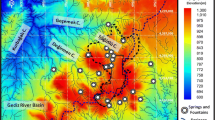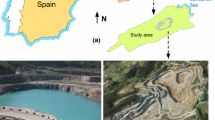Abstract
Dewatering requirements of three open pits located in western Turkey and the impact of dewatering on groundwater resources were evaluated using a three-dimensional numerical groundwater flow model. The groundwater was modeled using MODFLOW software and the dewatering was simulated using the MODFLOW Drain Package. The drain cell configurations were determined by pit boundaries; invert elevations of drains corresponded to the bench elevations in the mining schedule, which varied dynamically among the three pits. Transient model runs were conducted for the 21 years of mine life to calculate the monthly dewatering rates. Simulation results indicate that the average groundwater inflow to the excavations is 3.64 L/s, excluding the effects of direct rainfall into the pits and surface water flow from the benches. Long term (80 years) simulations were conducted to predict the amount of drawdown at the water supply wells in the area. The results indicate that 21 years of mining will not significantly impact the water levels in these wells. However, natural discharge from the springs near the pits will be exhausted by the dewatering.
Zusammenfassung
Die erforderliche Entwässerung von drei Tagebauen in der westlichen Türkei und die Auswirkung der Entwässerung auf Grundwasservorräte wurden mittels eines dreidimensionalen numerischen Grundwasserströmungsmodelles abgeschätzt. Das Grundwasser wurde mit MODFLOW modelliert und die Entwässerung wurde mit dem MODFLOW-Entwässerungspaket simuliert. Die Konfiguration der Drainagezellen wurde durch die Tagebaugrenzen bestimmt; die Höhe der Drainagen entsprach den Höhenlagen der Bermen in der Bergbauplanung, welche in den drei Gruben dynamisch wechselt. Instationäre Modelläufe wurden für 21 Jahre aktiven Bergbaues ausgeführt, um die monatlichen Entwässerungsraten zu berechnen. Resultate der Simulation zeigen, dass der durchschnittliche Grundwasserzustrom in die Abbaue 3.64 L/s beträgt, unter Auschluss der Auswirkungen von direktem Niederschlag in die Tagebaue und von Oberflächenabfluss der Böschungen und Bermen. Langzeitsimulationen (80 Jahre) wurden ausgeführt, um das Ausmaß der Wasserspiegelabsenkung in Förderbrunnen des Gebietes vorauszusagen. Die Ergebnisse zeigen, dass 21 Jahre aktiven Abbaues den Wasserspiegel dieser Brunnen nicht wesentlich beeinflussen. Quellen in der Nähe der Gruben werden allerdings trocken fallen.
Resumen
Se evaluaron los requerimientos para la deshidratación de 3 hoyos de mina abiertos en el oeste de Turquía y el impacto sobre las reservas de agua subterránea utilizando un modelo numérico de flujo de agua subterránea tridimensional El agua de lluvia se modeló usando el software MODFLOW y la deshidratación fue simulada usando MODFLOW. Las configuraciones de drenaje fueron determinadas utilizando los límites de cada hoyo; las inversiones de los drenajes correspondieron a las elevaciones de las terrazas de tierra durante el desarrollo de las prácticas mineras que variaron dinámicamente entre los tres hoyos. Simulaciones del modelo fueron realizadas para los 21 años de vida de la mina en función de calcular las velocidades de deshidratación mensuales. Los resultados de la simulación indican que la entrada promedio de agua subterránea a las excavaciones es 3,64 L/s, excluyendo los efectos de la caída de lluvias directamente dentro de los hoyos y el flujo de agua superficial desde las terrazas. Se realizaron simulaciones a largos plazos (80 años) para predecir el descenso de las reservas de agua en las cavidades en el área. Los resultados indican que 21 años de prácticas mineras no impactaron significativamente en los niveles de aguas en estas cavidades. Sin embargo, la descarga natural desde los manantiales cercanos a los hoyos estará agotada por la deshidratación.
抽象
利用三维地下水流模型评价了土耳其西部三个露天镍矿的含水层疏干及其对地下水资源的影响。MODFLOW模拟地下水流,MODFLOWk中的Drain Package模块模拟矿坑疏水。排水单元划分由随开采推进而不断变化的矿坑边界和排水底板标高(与露天矿坑开采阶段标高相当)决定,三个露天矿排水单元划分差异较大。非稳定流模型的镍矿服务期21年运用以预测矿坑每月涌水量;模拟结果表明,矿坑平均地下水排水量为3.74L/S(不包括从露天矿周边台阶汇入矿坑的地表径流)。利用模型80年长期运行结果,预测矿坑疏水对闭坑后水源井水位的长期影响;模拟结果显示,在21年的镍矿服务期内,疏干并不显著影响水源井水位,但采场附近泉的自然排泄将由于含水疏干而干涸。











Similar content being viewed by others
References
Adams R, Younger PL (2001) A strategy for modeling ground water rebound in abandoned deep mine systems. Groundwater 39(2):249–261
Agartan E, Yazicigil H (2012) Assessment of water supply impacts for a mine site in western Turkey. Mine Water Environ 31(2):112–128
Ardejani FD, Singh RN, Baafi E, Porter I (2003) A finite element model to: 1. Predict groundwater inflow to surface mining excavations. Mine Water Environ 22(1):31–38
Aryafar A, Ardejani FD, Singh RN (2009) Numerical modeling of groundwater inflow from a confined aquifer into Sangan open pit mine, northeast Iran. Geomech Geoengin Int J 4(3):189–199
Bochenska T, Fiszer J, Kalisz M (2000) Prediction of groundwater inflow into copper mines of Lubin Glogow Copper District. Environ Geol 39(6):587–594
Booth CJ (2006) Groundwater as an environmental constraint of longwall coal mining. Environ Geol 49(6):796–803
Brinkmann R (1966) Geotektonische Gliederung von Westanatolien. N Jb Geol Paleont Mh 10:603–618
Brouyere S, Orban PH, Wildemeersch S, Couturier J, Gardin N, Dassargues A (2009) The hybrid finite element mixing cell method: a new flexible method for modeling mine groundwater problems. Mine Water Environ 28(2):102–114
Brunetti E, Jones JP, Petitta M, Rudolph DL (2013) Assessing the impact of large-scale dewatering on fault-controlled aquifer systems: a case study in the Acque Albue basin (Tivoli, central Italy). Hydrogeol J 21(2):401–423
Connelly RJ, Gibson J (1985) Dewatering of the open pits at Letlhakane and Orapa diamond mines, Botswana. Int J Mine Water 4(3):25–41
Fernandez-Rubio R, Lorca DF (1993) Mine water drainage. Mine Water Environ 12(1):107–130
Fontaine RC, Davis A, Fennemore GG (2003) The comprehensive realistic yearly pi transient infilling code (CRYPTIC): a novel pit lake analytical solution. Mine Water Environ 22(4):187–193
Golder Associates Inc (2013) Conceptual design report for tailings and waste rock disposal areas, Caldag Nickel Project, Lakewood, CO, USA
Harbaugh AW, Banta ER, Hill MC, McDonald MG (2000) MODFLOW-2000, U.S. Geological Survey modular ground-water model: user guide to modularization concepts and the ground-water flow processes, USGS Open file Report 00-92, Washington DC, USA
Jiang S, Kong X, Ye H, Zhou N (2013) Groundwater dewatering optimization in the Shengli no.1 open-pit coal mine, Inner Mongolia, China. Environ Earth Sci 69(1):187–196
Marinelli F, Niccoli WL (2000) Simple analytical equations for estimating ground water inflow to a mine. Groundwater 38(2):311–314
Morton KL, Mekerk FA (1993) A phased approach to mine dewatering. Mine Water Environ 12(1):27–34
Rapantova N, Grmela A, Vojtek D, Halir J, Michalek B (2007) Ground water flow modeling applications in mining hydrogeology. Mine Water Environ 26(4):264–270
Singh RN, Atkins AS (1985) Analytical techniques for the estimation of mine water inflow. Int J Min Eng 3:65–77
Soil Conservation Services (SCS) (1964) SCS National engineering handbook, section-4: hydrology, updated. US Dept of Agriculture, Washington DC
Tavlan M, Darcan T, Dogruyol M (2008) Geology of Caldag Nickel Mine project area. (Interim report) Caldag Nickel Mining Inc., Turgutlu, Manisa, Turkey
Thornthwaite CW (1968) An approach towards a rational classification of climate. Geogr Rev 38(1):55–94
Tokgoz M, Yilmaz KK, Yazicigil H (2002) Optimal aquifer dewatering schemes for excavation of collector line. J Water Resour Plan Manag 128(4):248–261
Williamson S, Vogwill RIJ (2001) Dewatering in the hot groundwater conditions at Lihir gold. Proc, IMWA Symp, Belo Horizonte, pp 1–15
Yanik G, Uz B, Esenli F (2006) Geology of Neogene sediments of Turgutlu (Manisa) region. ITU J 5(2):49–58 [in Turkish]
Yazicigil H, Yilmaz KK, Peksezer-Sayit A (2013a) Hydrological and hydrogeological characterization of the Caldag Nickel Mine project area. Final Report, Project No 13-03-09-2-00-22, Middle East Technical Univ., Ankara, Turkey
Yazicigil H, Cankara-Kadioglu C, Peksezer-Sayit A (2013b) Dewatering of the open pits and assessing the potential impacts to groundwater resources. Final Report, Project No: 13-03-09-2-00-22, Middle East Technical Univ., Ankara, Turkey [in Turkish]
Zaidel J, Markham B, Bleiker D (2010) Simulating seepage into mine shafts and tunnels with MODFLOW. Groundwater 48(3):390–400
Acknowledgments
This project was funded by Caldag Nickel Mining Inc. through project No. 13-03-09-02-00-22 given to Middle East Technical University. The opinions, findings, conclusions, and recommendations expressed are those of the authors and do not necessarily reflect the views of Caldag Nickel Mining Inc. We thank the administrators and staff of Caldag Nickel Mining Inc. for the support they provided, especially Cevat Er, Ertan Akbulut, Derya Psav, Aylin Karacar, and Fatih Bozkurt. We thank Dr. Koray K. Yılmaz of Middle East Technical University for providing us with the groundwater recharge rates and Dr. Burcu Unsal for her support in the modeling. The positive and constructive comments provided by two anonymous reviewers are greatly appreciated.
Author information
Authors and Affiliations
Corresponding author
Electronic supplementary material
Below is the link to the electronic supplementary material.
10230_2014_306_MOESM2_ESM.pdf
Supplemental Fig 2 Sensitivity of the model errors to variations in hydraulic conductivities (a) and recharge rate (b) (PDF 846 kb)
Rights and permissions
About this article
Cite this article
Peksezer-Sayit, A., Cankara-Kadioglu, C. & Yazicigil, H. Assessment of Dewatering Requirements and their Anticipated Effects on Groundwater Resources: A Case Study from the Caldag Nickel Mine, Western Turkey. Mine Water Environ 34, 122–135 (2015). https://doi.org/10.1007/s10230-014-0306-4
Received:
Accepted:
Published:
Issue Date:
DOI: https://doi.org/10.1007/s10230-014-0306-4




